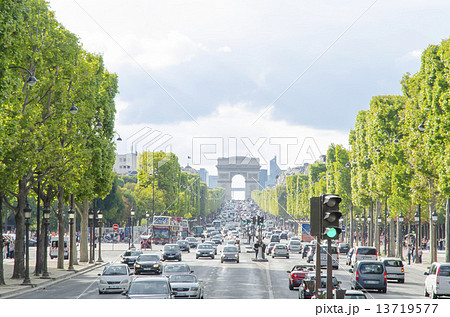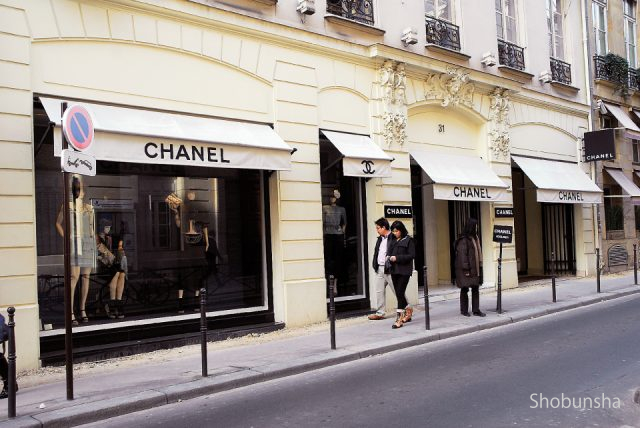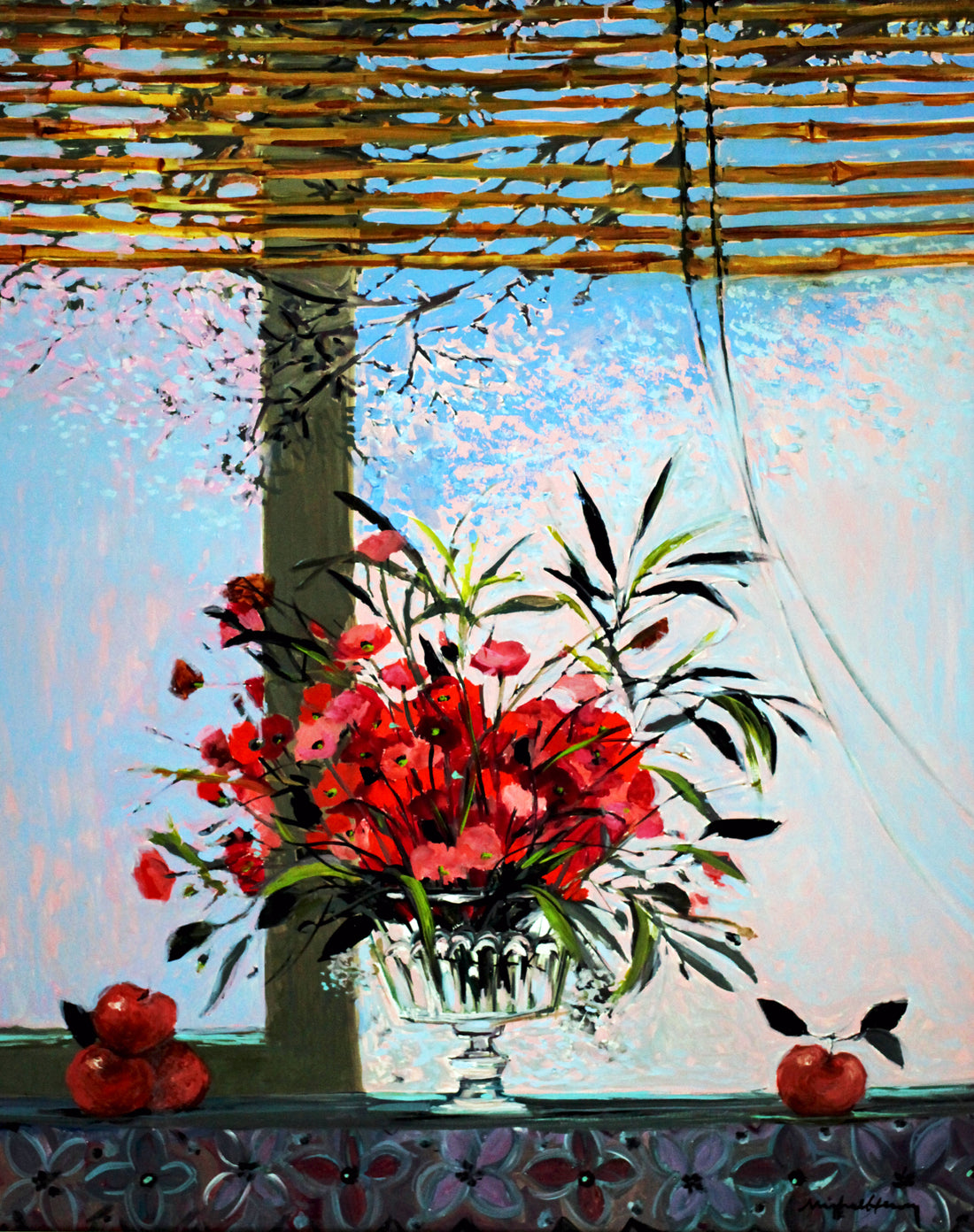Current gallery on Matignon Street ↓

Let me explain about Rue Matignon. The Arc de Triomphe is located on a small hill in the northwest of Paris, and if you turn right at the bottom of the gentle slope of the Champs-Élysées Avenue, which is said to be the most beautiful in the world, you will come to Rue Matignon, lined with art galleries.
You can see the Arc de Triomphe from the bottom of the slope on the Champs-Élysées.

If you turn left at the same place, you will reach Montaigne Street, where the headquarters of famous French brands are located.
The headquarters of over 10 brands, including Chanel and Dior, are lined up here. If you cross the Champs-Élysées from Avenue Montaigne, you will come to the high-end art gallery district of Rue Matignon.
Chanel Headquarters on Avenue Montaigne

About 100 meters down Rue Matignon, you will come to the intersection with Rue Faubourg Saint-Honoré, where high-end boutiques and ultra-luxury hotels are gathered. About 200 meters from Rue Matignon, sandwiched between the Champs-Élysées and Rue Faubourg Saint-Honoré, you will find the Elysée Palace and its gardens. The Elysée Palace is currently the presidential residence. In other words, politicians and business people from all over the world gather on Rue Matignon and Rue Faubourg Saint-Honoré, and this is where luxury brands and paintings are sold.
Luxury hotels in Faubourg Saint-Honoré

However, since the beginning of the 21st century, rent in Matignon has become too high, so many small galleries have opened in the Marais district of the 4th arrondissement (where the Picasso Museum is located), and this area has become more active.
The art galleries of the Marais district are gathered in the Place des Vosges.

Michel Henry had a long student life. He exhibited at various exhibitions and won awards during his student days. He studied abroad in the Netherlands, Spain, and Italy with the scholarships he received as a reward for those awards. By the time he finished his student life, Michel Henry was almost 30 years old.
When Michel Henry returned to Paris, he was welcomed by Galerie Romanée, a top-class gallery on the Rue Matignon, which had many popular artists of the time, including Michel Henry's teacher Chaplain Midi. The popular American actress Greda Garbo, originally from Sweden, was also known as a collector of art, and it was at Galerie Romanée that she purchased a painting by Michel Henry.
The location of the Gallery Romanee where Michel Henry first signed a contract is now a Japanese gallery.

Later, around 1970, the owner of the Romanee Gallery was getting old and had no successor, so the gallery was closed, and Michel Henry made a contract with the American Findlay Gallery, also on Matignon Avenue. For 20 years, Michel Henry not only exhibited at the Findlay Gallery in Paris, but also held solo exhibitions at Findlay Galleries in Chicago, Los Angeles, New York, Miami, and other cities every year, and visited the United States, and Americans frequently visited Michel Henry's villa in the south of France. Michel Henry was called the KING OF POPEE in the United States, as he often painted poppies as his subject matter.
Michel Henry's American Gallery Findlay, later
The former site of the Alexander Leodouse Gallery

Poppies (Coquelicot in French) have thin, translucent petals and bloom beautifully in nature, but if you cut them and put them in a vase, they will wither within half a day. Michel Henry loved the poppy's delicate and gorgeous colors, but at the same time, he loved its fleeting life and tried to capture its fleeting beauty forever on canvas, but it is doubtful whether Americans thought about the transience of poppies. They must have loved the brilliance of Michel Henry's bright colors and the splendor of his poppies in large compositions, and gave him the flashy title of "King of Poppies."
It's a matter of culture, but Americans are fond of saying " Oh, It's great," while the French say "C'est petit , petit" ( small and cute). Japanese people have a sensibility closer to the French than to the American sense, and they find beauty in the transience of life.
When looking at Michel Henry's bright red poppies, the Japanese are moved by their fleeting beauty, the French love their delicate beauty, and the Americans adore the large composition and the gorgeous splendor of the poppies blooming across the entire canvas. Michel Henry was loved in France, Japan and America.
Until around 1990, when Findlay Gallery withdrew from Paris, the contract was made with Sacy Gallery, owned by Etienne Sacy, who was the manager of the Paris branch of Findlay Gallery, and Japanese gallery Tenaga Gallery and Galerie Nichido, which had branches in Paris, were unable to do business with the gallery. Sacy made a lot of money by signing contracts with two very popular artists, Michel Henry and Brasilier, and opened a branch in New York, but Brasilier's son opened his own gallery on the Left Bank and started his own business, and also filed many lawsuits against Sacy. It seems that Brasilier lost each time, and Mr. Sacy became tired and closed his gallery in Paris to focus on his gallery in New York, but he passed away soon after.
During his contract with the Sacy Gallery, he was the subject of numerous acclaimed works, including French actress Jeanne Moreau, President Jacques Chirac and his wife,
Prime Minister Raymond Bart and his wife had a considerable collection of works, and after the closure of the Galerie Sacy, they continued to purchase from Michel Henry's next contract gallery, the Galerie Alexandre Léodouse.

With the closure of the Sacy Gallery, Michel Henry made a contract with the Alexandre Léodouse Gallery, also on Rue Matignon. The Alexandre Léodouse Gallery was based in Cannes, but had just opened a shop in Paris at the time. After that, they opened a gallery in Los Angeles, so Michel Henry would often stop by Los Angeles when he came to Japan.
The contract with Gallery Alexandre Léodouse continued until the end. In other words, from 1995 to 2016, Michel Henry was represented in France and the United States by Gallery Sassy on Rue Matignon, then by Gallery Alexandre Léodouse.
In Japan, our company, Galerie Adeka, was under contract.
In other words, Michel Henry had been a contract artist for the Matignon gallery, the most prestigious art gallery in Europe, since his late 20s. He continued to be a contract artist for the prestigious Matignon gallery for 65 years: about 10 years with the Romanée Gallery, about 20 years with the Findlay Gallery, about 15 years with the Sacy Gallery, and about 10 years with the Alexandre Léodouse Gallery.
The contract with Galerie Adeka ran for 21 years from 1995 to 2016, meaning that he has worked with Galerie Adeka longer than with any other gallery in Paris.

